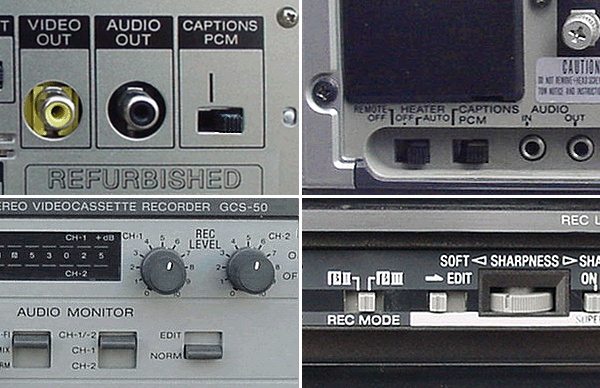Shortly after the introduction of the Betamax VCR Sony offered a digital stereo audio recording system known as Pulse Code Modulation (PCM for short). It used a separate device known as a decoder to convert analog stereo audio into a digital code (logic on and off pulses). This was then recorded onto video tape using a Betamax. When it was played back through the decoder the resulting stereo audio was almost perfect, with zero distortion. This was similar to what is used in CDs, but not the same as Betahi-fi, which came later. To learn more about PCM recording and the decoder go to PCM in my "Betamax Accessories" section. Almost all Betas will record a PCM signal without issue but playback requires that the Drop Out Compensation circuit or DOC be disabled. What is the DOC? It is a correction circuit used in all VCRs to compensate for lost or missing information caused by minor imperfections in the video tape. Without it you would see more dropouts, white lines or streaks in your playback picture than is acceptable. It works by storing a preceding frame in memory and using it to fill in any bad spots that show up in the video being played. The DOC only affects the video coming out. It has no affect on input. But PCM uses the video out signal and the DOC causes problems when playing back PCM recordings. This is because it fills in the missing information (drop outs) with digital nonsense. To rectify this problem Sony added a switch to most of their VCRs for turning off the DOC. The switch location can be inside the front component door or on the back (see bottom pictures). Consult your models owners manual for the exact location. Turning ON the PCM switch turns off the DOC circuit. Just the opposite of what you would think. ON if off and OFF is on. Turning it off and all the picture processing circuits are on and that can get in the way of a clear signal coming straight from the Betamax. Having this unaltered signal can work to your benefit in other ways. Especially when editing from one Betamax to another or making multiple copies. This is because no processing is being performed by the VCR to change the picture. It is just straight unaltered signal. This same strategy is accomplished with an EDIT switch found of some of high end Betas. It too turns off the DOC circuit. But forgetting and leaving these switches in the ON position can create a minor headache. Leaving them in the ON position during normal playback lets you see all of the tapes little bugs and imperfections. This is not only annoying but could also mislead one into believing there is something wrong with their VCR. So if you see more than the normal specks or streaks in your picture check the PCM or EDIT switch to make sure they are in the OFF position, as shown below. To see these switches in action during playback move them OFF and ON while watching the monitor. Normal position is OFF. Only use these switches to make better VCR to VCR copies or when using a PCM decoder. When making copies to DVD you will probably want the benefit of the DOC circuit to clean up the video coming out. The switches shown below are all in the OFF position. To see a list of Beta VCRs that have a dedicated PCM switch click here. Note: All Beta VCRs will record the PCM output. Playback is the where the switch becomes important. To see a list of Beta VCRs that have a EDIT switch click here. homepage ©Misterßetamax |
